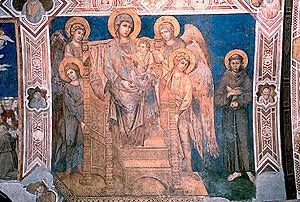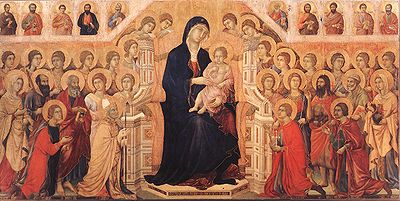
Maestà
Encyclopedia


Iconography
Iconography is the branch of art history which studies the identification, description, and the interpretation of the content of images. The word iconography literally means "image writing", and comes from the Greek "image" and "to write". A secondary meaning is the painting of icons in the...
of the enthroned Madonna
Madonna (art)
Images of the Madonna and the Madonna and Child or Virgin and Child are pictorial or sculptured representations of Mary, Mother of Jesus, either alone, or more frequently, with the infant Jesus. These images are central icons of Roman Catholicism and Eastern Orthodox Christianity where Mary remains...
with the child Jesus
Child Jesus
The Child Jesus represents Jesus from his Nativity to age 12. At 13 he was considered to be adult, in accordance with the Jewish custom of his time, and that of most Christian cultures until recent centuries.The Child Jesus is frequently depicted in art, from around the third or fourth century...
, whether or not accompanied with angel
Angel
Angels are mythical beings often depicted as messengers of God in the Hebrew and Christian Bibles along with the Quran. The English word angel is derived from the Greek ἄγγελος, a translation of in the Hebrew Bible ; a similar term, ملائكة , is used in the Qur'an...
s and saint
Saint
A saint is a holy person. In various religions, saints are people who are believed to have exceptional holiness.In Christian usage, "saint" refers to any believer who is "in Christ", and in whom Christ dwells, whether in heaven or in earth...
s. The Maestà is an extension of the "Seat of Wisdom
Seat of Wisdom
In the Roman Catholic tradition, the epithet "the Seat of Wisdom" or "Throne of Wisdom" is identified with one of many devotional titles for the Mother of God...
" theme of the seated "Mary Theotokos
Theotokos
Theotokos is the Greek title of Mary, the mother of Jesus used especially in the Eastern Orthodox, Oriental Orthodox, and Eastern Catholic Churches. Its literal English translations include God-bearer and the one who gives birth to God. Less literal translations include Mother of God...
", "Mary Mother of God", which is a counterpart to the earlier icon of Christ in Majesty
Christ in Majesty
Christ in Majesty, or Christ in Glory, in Latin Majestas Domini, is the Western Christian image of Christ seated on a throne as ruler of the world, always seen frontally in the centre of the composition, and often flanked by other sacred figures, whose membership changes over time and according to...
, the enthroned Christ that is familiar in Byzantine Mosaics. Maria Regina is an art historians' synonym for the icon
Icon
An icon is a religious work of art, most commonly a painting, from Eastern Christianity and in certain Eastern Catholic churches...
ic image of Mary enthroned, with or without the Child.
In the West, the image seems to have developed, based perhaps on Byzantine precedents such as the coin of Constantine's Empress Fausta
Fausta
Fausta Flavia Maxima was a Roman Empress, daughter of the Roman Emperor Maximianus. To seal the alliance between them for control of the Tetrarchy, in 307 Maximianus married her to Constantine I, who set aside his wife Minervina in her favour. Constantine and Fausta had been betrothed since...
, crowned and with their sons on her lap and on literary examples, such as Flavius Cresconius Corippus
Flavius Cresconius Corippus
Flavius Cresconius Corippus was a late Roman epic poet of the 6th century, who flourished under East Roman Emperors Justinian I and Justin II. His major works are the epic poem Johannis and the panegyric In laudem Justini minoris...
's celebration of Justin II
Justin II
Justin II was Byzantine Emperor from 565 to 578. He was the husband of Sophia, nephew of Justinian I and the late Empress Theodora, and was therefore a member of the Justinian Dynasty. His reign is marked by war with Persia and the loss of the greater part of Italy...
's coronation in 565. Paintings depicting the Maestà came into the mainstream artistic repertory, especially in Rome, in the late twelfth and early thirteenth centuries, with an increased emphasis on the veneration of Mary. The Maestà was often executed in fresco
Fresco
Fresco is any of several related mural painting types, executed on plaster on walls or ceilings. The word fresco comes from the Greek word affresca which derives from the Latin word for "fresh". Frescoes first developed in the ancient world and continued to be popular through the Renaissance...
technique directly on plastered walls or as paintings on gessoed wooden altar
Altar
An altar is any structure upon which offerings such as sacrifices are made for religious purposes. Altars are usually found at shrines, and they can be located in temples, churches and other places of worship...
panels
Panel painting
A panel painting is a painting made on a flat panel made of wood, either a single piece, or a number of pieces joined together. Until canvas became the more popular support medium in the 16th century, it was the normal form of support for a painting not on a wall or vellum, which was used for...
.
A more domestic representation, suitable to private devotion, is the iconographic theme of Madonna and Child.
Examples of Maestà in painting
The most famous example of the Maestà is the Maestà with Twenty Angels and Nineteen Saints, an altarpieceAltarpiece
An altarpiece is a picture or relief representing a religious subject and suspended in a frame behind the altar of a church. The altarpiece is often made up of two or more separate panels created using a technique known as panel painting. It is then called a diptych, triptych or polyptych for two,...
comprising many individual paintings commissioned by the city of Siena
Siena
Siena is a city in Tuscany, Italy. It is the capital of the province of Siena.The historic centre of Siena has been declared by UNESCO a World Heritage Site. It is one of the nation's most visited tourist attractions, with over 163,000 international arrivals in 2008...
in 1308 from the artist Duccio di Buoninsegna. The painting was installed in the city's cathedral on June 9, 1311. Although it took a generation for its effect truly to be felt, Duccio's Maestà set Italian painting on a course leading away from the hieratic representations of Byzantine art towards more direct presentations of reality.
Creating this altarpiece assembled from many wood panels bonded together before painting was an arduous undertaking. The work was not only large, the central panel was 7 by 13 feet, but it had to be painted on both sides since it could be seen from all directions when installed on the main altar at the centre of the sanctuary.
On the back of the Maesta were episodes from the life of Christ, focusing on his Passion. Sacred narrative unfolds in elegant episodes enacted by graceful figures who seem to dance their way through these stories while still conveying emotional content.
Because the Maesta was dismantled in 1771, its power and beauty can only be imagined from scattered parts, some still in Siena, Italy, but others elsewhere.
Other noted examples of the Maestà are Simone Martini
Simone Martini
Simone Martini was an Italian painter born in Siena.He was a major figure in the development of early Italian painting and greatly influenced the development of the International Gothic style....
's Maestà in the Palazzo Pubblico
Palazzo Pubblico
The Palazzo Pubblico is a palace in Siena, Tuscany, central Italy. Construction began in 1297 and its original purpose was to house the republican government, consisting of the Podestà and Council of Nine....
, Siena, or Cimabue
Cimabue
Cimabue , also known as Bencivieni di Pepo or in modern Italian, Benvenuto di Giuseppe, was an Italian painter and creator of mosaics from Florence....
's fresco in the Basilica of San Francesco d'Assisi
Basilica of San Francesco d'Assisi
The Papal Basilica of St. Francis of Assisi is the mother church of the Roman Catholic Order of Friars Minor—commonly known as the Franciscan Order—in Assisi, Italy, the city where St. Francis was born and died. The basilica is one of the most important places of Christian pilgrimage in Italy...
.

